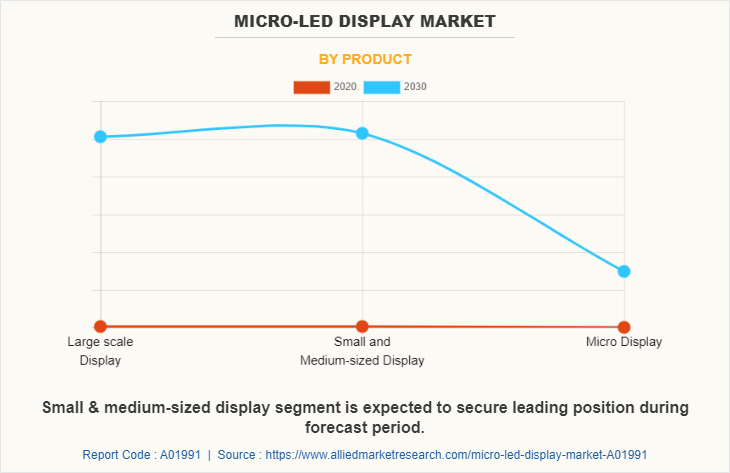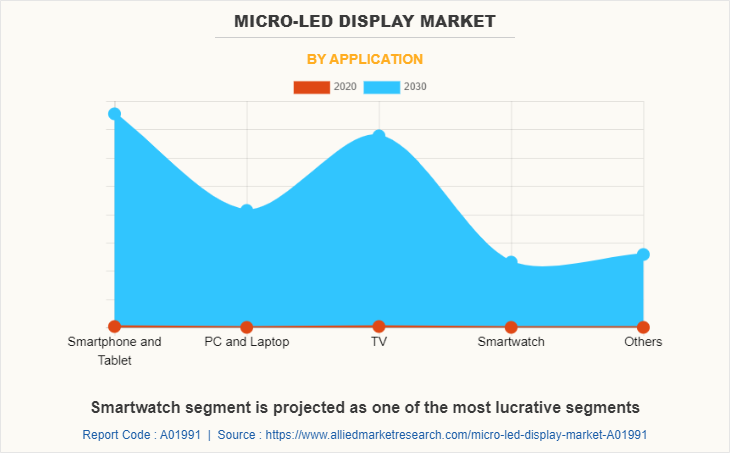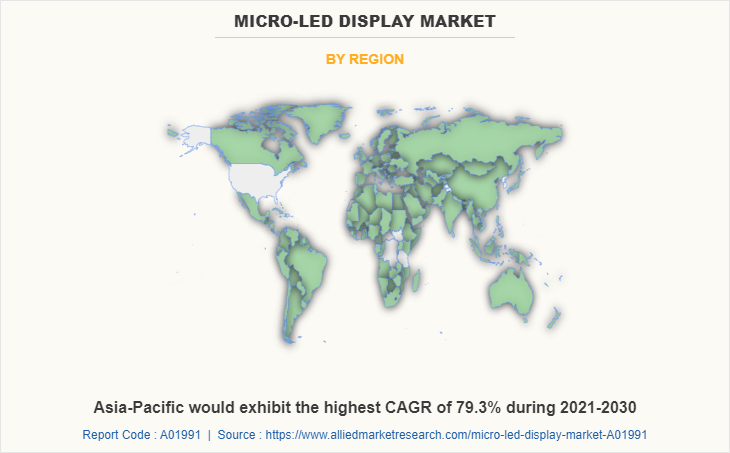Micro-LED Display Market Research, 2032
The Global Micro-LED Display Market size was valued at $56.00 million in 2020, and is projected to reach $23.4 billion by 2030, growing at a CAGR of 77.1% from 2021 to 2030.
Micro-LEDs are a class of displays in which individual pixels are formed by an array of microscopic light-emitting diodes (LEDs). Micro-LED display provides high wavelength uniformity for fine pixel pitch display. In addition, it has added advantages of less power consumption, increased brightness, ultrahigh definition picture quality, improved color saturation, and faster response rate as compared to OLEDs and LCDs.

The global micro-LED display market growth is driven by rise in demand for bright and power-efficient display panels and increase in preference of electronic giants such as Sony and Apple toward micro-LEDs display. However, high cost of these displays is expected to restrain the market growth. On the contrary, rise in demand for consumer electronics is anticipated to provide lucrative growth opportunities for the market.

Segment Overview
The micro-LED display market analysis is provided on the basis of product, application, industry vertical, and region. On the basis of product, the market is divided into small- & large-scale display, small- & medium-sized display, and micro display. By application, it is categorized into smartphone & tablet, TV, PC & laptop, smartwatch, and others.

Depending on industry vertical, it is fragmented into consumer electronics, entertainment & sports, automotive, retail, government & defense, and others. Region wise, the micro-LED display market trends are analyzed across North America, Europe, Asia-Pacific, and LAMEA.

Top Impacting Factors
The significant impacting factors in the micro-LED display market include rise in demand for bright and power-efficient display panels and increase in preference for electronic giants toward micro-LED displays, which fuels the growth of the market. However, high cost of micro-LED display is expected to hinder the growth of the micro-LED display market. Conversely, upsurge in demand for the consumer electronics is projected to offer remunerative micro-LED display market opportunity. Each of these factors is anticipated to have a definite impact on the market during the forecast period.
Rise in demand for bright and power-efficient display panels
Micro-LED display is an emerging technology, which is a collection of microscopic LEDs that form an individual pixel element. It offers enhanced contrast over the traditional OLED and LED display technologies. In addition, the consumption of the power by micro-LED display is less as compared to the other technologies such as LEDs and OLEDs. Thus, rise in demand for such brighter and power-efficient devices fuels the growth of the micro-LED display industry.
Upsurge in demand for consumer electronics
Significant rise in demand for consumer electronics has been witnessed especially in the developing countries such as India, China, and others. Factors such as rise in disposable income and improvement in standard of living among middle class population propel the demand for consumer electronics. In addition, microLED display applications such as smartphones, microLED TV, laptops, smartwatches, and others in the consumer electronics segment are expected to rise rapidly during the forecast period. Thus, the emergence of such applications is projected to fuel the need of micro displays in the future.
Covid-19 Impact Analysis
COVID-19 pandemic has adversely impacted the micro-LED display market as huge workforce of enterprises across the globe is working from home. This has LED to decline in advertising expenditure, which, in turn, reduced the demand for micro-LED displays. Although the COVID-19 pandemic has forced field work of several major projects to pause temporarily, the market is expected to remain robust with cumulative number of shipments being marginally unaffected in the next three-year period from 2020.
The global micro-LED display industry has been impacted by the COVID-19 outbreak. New projects throughout the world have been stalled, which, in turn, have affected demand in several industries including manufacturing, industrial, and retail. Although market players faced minimal impact on procuring raw materials, time and shipping costs was still a major concern.
Moreover, rise in investments in development of smart cities have gained importance during the pandemic, subsequently, the demand for micro-LED display is anticipated to gain momentum post-pandemic.
Competitive Analysis
The key players profiled in the report include Aledia, Apple Inc., eLux, Inc., Glo AB, LG Display, PlayNitride Inc., Rohinni LLC, Samsung Electronics Co. Ltd., Sony Corporation, and VueReal. These key players have adopted strategies, such as product portfolio expansion, mergers & acquisitions, agreements, geographical expansion, and collaborations to enhance their position in the micro-LED display market.
Key Benefits for Stakeholders
- This study comprises analytical depiction of the global micro-LED display size along with the current trends and future estimations to depict the imminent investment pockets.
- The overall micro-LED display market outlook is determined to understand the profitable trends to gain a stronger foothold.
- The report presents information related to key drivers, restraints, and opportunities with a detailed impact analysis.
- The micro-LED display market forecast is quantitatively analyzed from 2021 to 2030to benchmark the financial competency.
- Porter’s five forces analysis illustrates the potency of the buyers and suppliers in the industry.
- The report includes the micro-LED display market share of key vendors and market trends.
Micro-LED Display Market Report Highlights
| Aspects | Details |
| By Product |
|
| By Application |
|
| By Industry Vertical |
|
| By Region |
|
| Key Market Players | Samsung Electronics Co. Ltd., Aledia, Apple Inc., LG Display, PlayNitride Inc., Glo AB, eLux Inc., Sony Corporation, VueReal, Rohinni LLC |
Analyst Review
The micro-LED display market holds high growth potential. This is attributed to the fact that in the current business scenario, there has been an increase in demand for brighter and more power-efficient display panels for several applications such as smartphones, TVs, PCs, and smartwatches. Companies in this industry have adopted various innovative techniques to provide customers with advanced and innovative product offerings.
The global micro-LED display market is expected to witness high growth rate in the future due to high efficiency offered by LEDs display and increase in preference of electronic giants towards micro-LED displays. However, high cost of micro-LED display impede the market growth.
Considering the regional trends of the micro-LED display market, North America is expected to account for the highest revenue in the global market throughout the forecast period. However, Asia-Pacific is expected to grow at a higher growth rate, predicting a lucrative market growth for micro-LED display industry.
The key players profiled in the report include Aledia, Apple Inc., eLux, Inc., Glo AB, LG Display, PlayNitride Inc., Rohinni LLC, Samsung Electronics Co. Ltd., Sony Corporation, and VueReal.
The global micro-LED display market growth is driven by rise in demand for bright and power-efficient display panels and increase in preference of electronic giants such as Sony and Apple toward micro-LEDs display
By end user, consumer electronics segment is expected to dominate the global micro-LED display market.
North America is the largest regional market for Micro-LED Display Market.
The global micro-LED display market size was valued at $56 million in 2020.
The key players profiled in the report include Aledia, Apple Inc., eLux, Inc., Glo AB, LG Display, PlayNitride Inc., Rohinni LLC, Samsung Electronics Co. Ltd., Sony Corporation, and VueReal.
The key players have adopted strategies, such as product portfolio expansion, mergers & acquisitions, agreements, geographical expansion, and collaborations to enhance their position in the micro-LED display market.
Loading Table Of Content...



